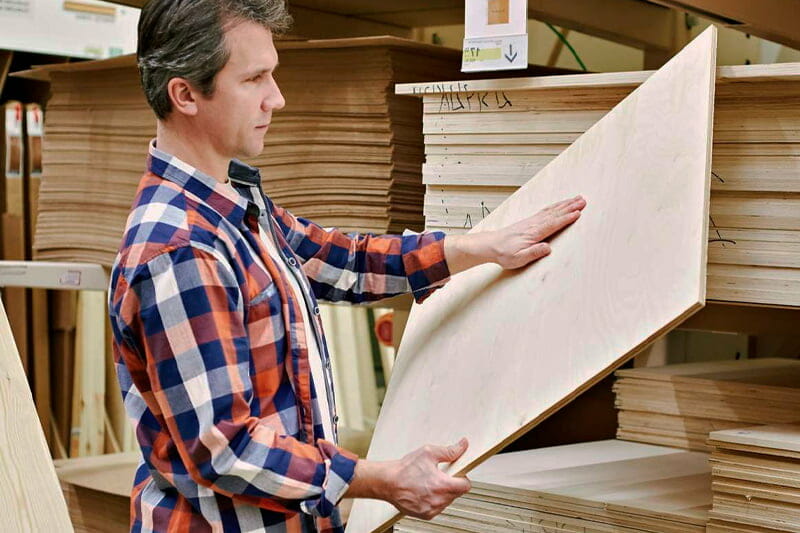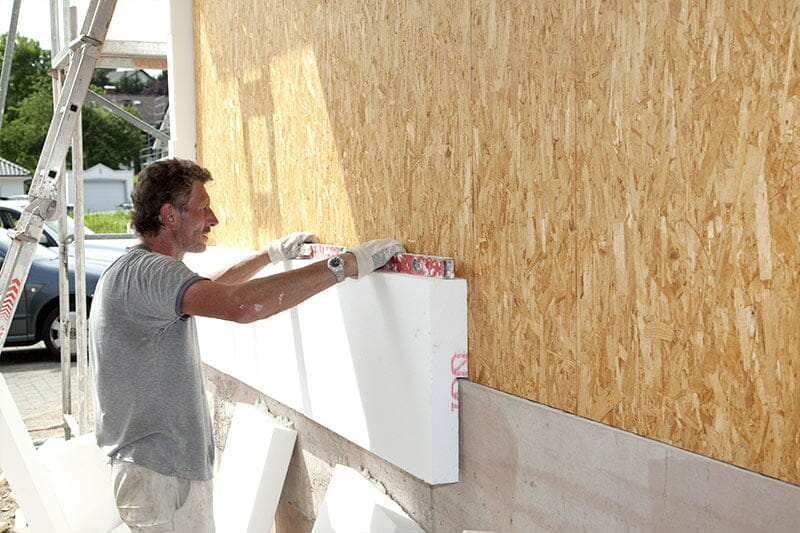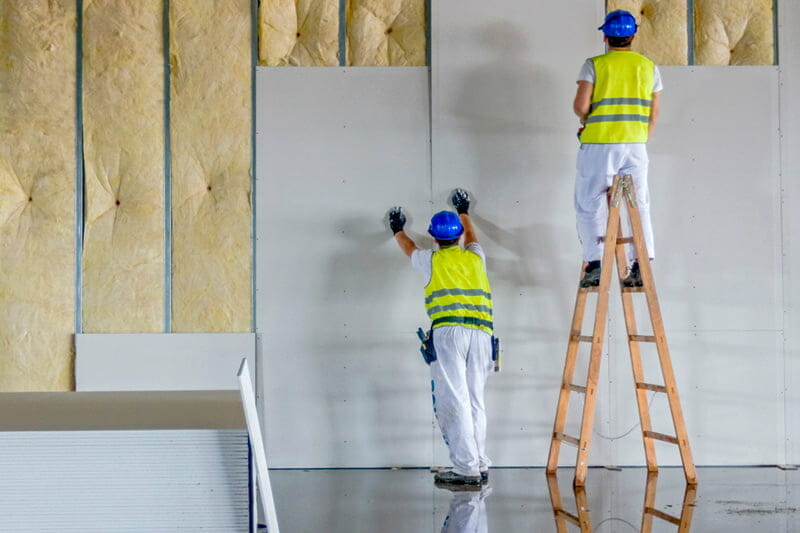Significant differences exist in the insulation and soundproofing performances of plywood versus drywall in residential environments.
Plywood insulates 37% better than drywall. While half an inch of drywall has an R-value of about 0.45, plywood of the same thickness has an R-value of 0.62.
Below is what you should know about plywood and drywall; and their ability to insulate a home.
R-value = Thermal resistance value or the capacity of the material to resist the flow of heat and cold.

Drywall vs Plywood insulation
Plywood boards provide good insulation at a certain thickness. This is because, at half an inch of thickness, it has an R-Value of 0.62 compared to a 1/2 inch drywall R-Value of 0.45.
The minimum recommended R-Value for interior walls is 0.13.
| Material | Thickness | R-Value |
|---|---|---|
| Plywood | 1/2" | 0.62 |
| Plywood | 1" | 1.25 |
| Standard drywall | 1/2" | 0.45 |
| Standard drywall | 1" | 1.08 |
Is it OK to use plywood instead of drywall?
It is Ok to use plywood instead of drywall for interior spaces. If you want to insulate your home’s exterior, I recommend using plywood in conjunction with other materials.
You are best using foam and siding to finish a home’s exterior insulation. There are different standards for different extreme weather conditions depending on where you live in the country, so be sure to follow local building guides and standards.
What is the best exterior insulation to use with plywood?
Rigid foam insulation is the best insulation for plywood. This is because it is easy to cut, making it easy to fit onto plywood sheets. There is also the fact that all you need to do to attach to plywood is to apply glue in a zigzag pattern and then press it onto the plywood. And after that, simply taping the boards with weatherproof tape is all that is required to arm your interior walls with the insulation that they need.

What are the advantages and disadvantages of plywood?
As a building material, plywood has a number of distinct advantages and disadvantages. Here are the ones that stand out.
Pros
- It is a relatively lightweight material. This makes it extremely easy to work with.
- This is one of the main reasons why it is a favorite among DIY enthusiasts.
- It is aesthetically pleasing to the eye thanks to the beauty of the natural wood grain patterns that plywood boards have
- It can hold paint well and it is also very easy to paint
- Plywood offers a high degree of resistance to impact
- It has a high weight-to-strength ratio
- It is a generally stable material
- It is relatively more affordable when compared to solid wood
Cons
- It is not as readily available in the market as other materials like drywall
- It is susceptible to moisture damage and rotting
- It easily bends and sags when longer pieces aren’t given enough structural support
- It is made up of toxic materials, some of which can cause cancer
- It is relatively more expensive when compared to cheaper materials like drywall
What are the advantages and disadvantages of using drywall as a wall material?
As a building material for covering interior walls, drywall, or sheetrock, has a number of benefits and shortcomings. Here are the ones that stand out.
Pros
- It is very affordable
- It is a building material that is readily available in the market
- It is very easy to repair drywall given that most repairs can be done with drywall mud and paper or fiberglass tape. The average person can fix common drywall dents and cracks.
- It is fire-resistant
- It has a moisture-resistant option that is great for use in bathrooms and kitchens
- It offers a respectable degree of soundproofing
- It is not susceptible to rotting or insect infestations
Cons
- Compared to other materials like plywood, drywall is heavy, which makes it an installation challenge. And when you consider that you still have to make its joints smooth by sanding them, installing it is not as easy as installing other materials.
- It can be easily damaged by sharp objects and other materials in the home. This is so especially when it hasn’t been plastered
- It does not have as much structural strength as plywood. This means that it is not great at holding screws and fasteners which makes it challenging to hang items like family photos. The only way in which you can hang heavy items is to use the wood studs for support.
- It is not as attractive because it does not have the natural wood grain pattern of plywood.
- It is not as durable as plywood
Comparing Plywood vs Drywall
Drywall and plywood are typical materials that homeowners use to cover their walls.
Here is a plywood vs drywall comparison that is based on characteristics that matter to most homeowners.

Affordability
Drywall is more affordable than plywood.
Drywall costs between $1.50 and $3 per square foot, while plywood costs between $3.50 and $7.20 per square foot. This difference in costs is one of the main reasons why homeowners prefer using drywall over plywood as an interior wall treatment.
Insulation of plywood walls vs drywall walls
When compared on a per-inch basis, plywood provides better insulation than drywall. This is because ½ “ of drywall has an R-Value of 0.45 while the same thickness of plywood has a value of 0.62.
Soundproofing
Drywall has better soundproofing characteristics.
It is better at soundproofing a home’s interior walls. This is because sound waves do not move as easily through a combination of gypsum and crystallized water, as it does through wood.
However, a single sheet of drywall, or even of cement board or any other material, is rarely sufficient to give a home enough soundproofing.
Additional layers are often needed, with most homeowners getting the best results, by sandwiching mass-loaded vinyl between two drywall sheets.
At the very minimum, double layering is necessary. This is because using two layers of drywall will create a better buffer, and hence dampening effect.
They also tend to use green glue. This is because green glue helps to hold the different soundproofing materials together. By doing so, the green glue essentially keeps the plywood and the vinyl from vibrating, something that usually goes a long way towards enhancing the soundproof quality of the entire soundproof wall system.
Another thing that one can do to enhance soundproofing is to replace wood studs with metal studs. The use of acoustic putty also tends to yield significant results.
Fire resistance
Drywall is more fire-resistant than plywood.
It has superior fire resistance simply because it is a gypsum board — that is made up of crystallized water and gypsum.
As a result, if you have regular drywall installed on your walls, it can slow down the spread of fire by up to 30 minutes.
You can get even better results with fire-rated drywall as this drywall can resist direct flames for up to over an hour, and hence the reason why it is typically labeled with a one-hour fire rating.
It is because of this reason that residential building codes usually require homeowners to use drywall (Type X drywall) to cover the walls of an attached garage or any other area that is considered to be a higher fire hazard risk. Compliance with this requirement typically means covering studs of walls separating the living space from such areas with either type X or type C drywall.
Since plywood is generally made out of thin sheets of wood, it is less resistant to fire. As a result, no local building authority recommends its use as a way of improving fire safety. Covering wall studs with this material does nothing as far as improving the fire resistance of the wall is concerned.
Repairs
It is easier to make repairs on drywall than on plywood. This is because all you need to repair existing sheetrock is drywall mud, a utility knife, and some tape. And while sanding and patching are often necessary to give the drywall an attractive finish, it is not mandatory. Furthermore, creating popular orange peel textures or the typical familiar knock-down effect on drywall isn’t that hard.
Most plywood, on the other hand, isn’t as easy to repair. It doesn’t have easy fixes such as applying joint compound. In some cases, even the slightest of damage can call for the replacement of an entire panel.
Installation
Generally, a plywood sheet will weigh less than a comparable sheet of drywall. They are thus easier to install simply because they are lighter. And the fact that they are more accepting of fasteners like nails is a bonus that makes them ideal for areas that need extra storage spaces.
Consequently, because of the weight of drywall, installing it is usually no less than a two-person job. It requires more than one person to complete it successfully. Drywall installation also requires extra steps like mudding, sanding, and taping, something that makes plywood installation a relatively less cumbersome process.
Aesthetic appeal
Drywall cannot match the beauty and warm decorative effect of the patterns that wood grain naturally gives finished plywood boards — especially furniture-grade hardwood plywood. Therefore, if the beauty of your walls is a major deciding factor in terms of which material to use, then you should go with finished plywood.
Is there insulated plywood?
Yes, there is insulated plywood and it is generally referred to as Plywood SIPS. These panels are effective at providing insulation mainly because they are made up of three layers: two plywood panels and a core that is made up of insulating foam.
What are the different types of plywood cores?
Not all plywood boards are created equal. They vary widely in terms of their evenness, consistency, strength, and weight. These differences stem from the fact that their cores are made up of different materials.
MDF (Medium Density Fiberboard) core
While MDF core plywood isn’t great at holding screws and fasteners, it is smoother and more even — especially when it has a hardwood veneer — than veneer core plywood. It also has an edge as far as evenness is concerned.
However, if one is looking for lightweight material, an MDF core will definitely not be the ideal choice primarily because of its weight.
Veneer core
Veneer core plywood is lightweight, rigid, and strong. These are qualities that it has thanks mainly to the fact that it is made of multiple hardwood layers that are cross-banded together. It is an ideal choice in cases where one needs a plywood solution that has a good screw-holding capacity — even MDF core plywood can’t offer as good screw-holding benefits.
Particleboard core plywood
This type of plywood is even, has a consistent thickness, and is the most affordable plywood option. However, it doesn’t do so well in terms of holding screws. This, in addition to the fact that it isn’t as readily available as the other options, makes it to be a not-so-sought-after plywood option.
The other core options include lumber core and combination core plywood boards.
Can plywood be used as exterior insulation?
No, plywood cannot be used as an effective way of insulating an existing wall. This is because it has a low R-Value (0.62), which means it offers below the standard of R-13 – 23.
This means you will need to layer other insulation materials to finish the exterior of your home including foam and siding material.
FAQ's
The best insulation for drywall is fiberglass insulation. This is because it is not only more affordable than other types of drywall insulation, but also remarkably easy to install.
Yes, exposed insulation is bad for you. This is because the insulation is generally made up of tiny particles that can get airborne. And once they do, they can find their way into your respiratory system. They can then cause respiratory complications.
Yes, plywood has some insulation value. Half an inch of plywood has an R-Value of 0.62.
While this means that it provides some form of insulation, the insulation level is negligible. Therefore, if you are interested in boosting your home’s energy efficiency, opting for plywood walls won’t answer your problems.







